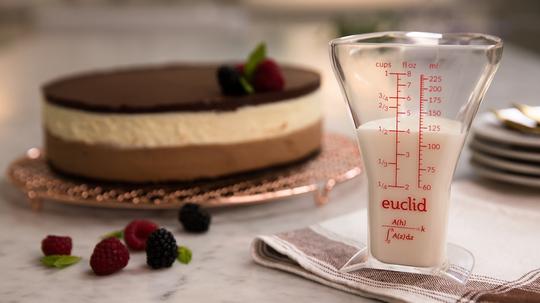
For Joshua Redstone, the realization that something was wrong with measuring cups came around four years ago, while he was baking bread in his Manhattan apartment. On that occasion, he tried to use a 2-cup measuring cup, but the tool didn't feel quite right to him.
"Traditional measuring cups have this problem that they get worse measuring small amounts."
"The recipe called for a quarter cup," Redstone, an Amherst native who moved back to Cambridge after working for Facebook and Google in Silicon Valley, said. "Traditional measuring cups have this problem that they get worse measuring small amounts."
After many calculations, Redstone came up with a mathematical solution to the problem that translated into a new kind of measuring cup. Quite appropriately, Redstone named his invention after the founding father of geometry: Euclid.
To manufacture the first set of products, in late September Redstone launched a Kickstarter campaign that met the goal of $30,000 on day four. Currently, bakers have donated over $50,000.
Here's a video showing Euclid in action - measuring exactly one cup of reduced fat milk:
The problem with traditional measuring cups is that they are usually in the shape of, well, cups. As Redstone pointed out, their surface area is roughly the same across the entire object. Think of a cylinder: the area of the circle at the bottom is the same as the area of the circle at the top.
Now, imagine pouring milk in a cylinder-shaped cup and overshooting by a millimeter. In your cup, there's now the right quantity of milk, plus an amount of milk that's one millimeter high and an entire surface area wide. That excess will have a bigger overall impact on a small quantity of milk because of the constant surface area, which plays the biggest role in determining the extra volume of milk.
As a mathematician - Redstone - would say: "It's the ratio of surface area to volume that determines your error."
As a solution to the problem, Euclid's shape keeps the ratio of surface area to volume constant. "You measure half as much, the cup is half as wide," Redstone said. In other words: by letting the surface area change according to the quantity of liquid, the error will be the same when measuring small quantities as well as large quantities.

"There's a bunch of people who are excited about Euclid because... it gives them one less thing to worry about," Redstone said. "So they can focus their energies on cooking... without worrying about, 'Am I using the right sized measuring cup? Is that the thing that screwed up my brownies?'"
Redstone said he plans to start manufacturing as soon as the Kickstarter campaign ends on Oct. 28.








